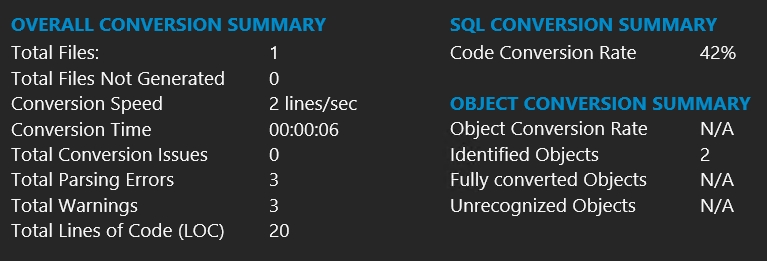Assessment Report
This is a deprecated version of the SnowConvert documentation, please visit the official site HERE.
General Summary
This is a document that summarizes the estimation of code conversion rate and many other useful information for the user to estimate how far are they to achieve a functional equivalent snowflake code.

The most important information on the above screen are:
Total Parsing Errors: The number of conversion elements that were not converted due to the parser not being about to process a specific object or element. Again, you can learn more about issues and errors in SnowConvert by visiting our page on Issues and Troubleshooting.
Code Conversion Rate: This is an estimation of the conversion rate based on the characters. For example, if you have 100 characters and 50 characters have some parsing or conversion errors, then the estimated code conversion rate would be 50 percent.
Identified Objects: The count of all the Top Level DDL Objects ( Table, View, Procedure, etc.. ) that the SnowConvert identified. If there were a parsing error on an object, it wouldn't be an Identified Object. Example: The first objects from line #1 to line #6. There is evidently a parsing error, so the SnowConvert cannot identify that as an object.
File and Object-Level Breakdown
SQL - Files
File
Conversion Rate
Lines of Code
Total Object Quantity
Parsing Errors
SQL
42%
20
2
3
In this section, you'll get the overall assessment summary information for all the SQL Files
Code Conversion Rate: This is an estimation of the conversion rate based on the characters of the given SQL Files.
Line of Code: The count for the lines of code of the given SQL Files.
Total Object Quantity: The count of total identified objects of the given SQL Files.
Parsing Errors: The count of total parsing errors of the given SQL Files.
The Unrecognized objects will be counted also a parsing errors of the SQL Files section
The Code conversion rate may differ from Identified conversion rate because this is also considering the unrecognized objects.
SQL - Identified Objects
Object
Conversion Rate
Lines of Code
Total Object Quantity
Parsing Errors
Tables
67%
5
1
1
Views
57%
7
1
1
Procedures
-
0
0
0
Functions
N/A
N/A
N/A
N/A
In this section, you'll get the assessment information for all the identified objects divided by the DDL objects like Tables, Views, Procedures, etc.
If there is a code where the parser couldn't handle it, the entire object will be accounted as Unrecognized Object, and therefore it wouldn't show here
Code Conversion Rate: This is an estimation of the conversion rate based on the characters for the identified objects like Table, View, Procedure, etc.
Line of Code: The count for the lines of code of each type of identified object.
Total Object Quantity: The count for each type of identified object.
Parsing Errors: The count for the parsing errors that occurred inside each type of identified object.
Example: For the 2 tables that we have in the source code, one is an unrecognized object and one is succesfully identified. The conversion rate of that table of 5 lines of code is 75% due to 1 parsing error.
Issues Breakdown

In this page, you will get the number of unique issues and the list of issues ordered by severity in descendant sort.
For example, for the given source code, we have 2 critical issues related to parsing errors and one medium severity issue related to the Not supported function.
Last updated
